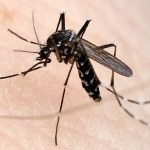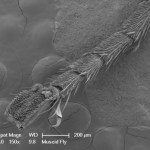insects
They looked like little flowers, or miniature suction cups, but yesterday's mystery was neither. Here's a more recent view:
Arilus cristatus, a newly hatched wheel bug nymph with eggs
Ted MacRae of Beetles in the Bush picks up 6 points for guessing that they were Reduviid eggs, and MarekB gets 4 for nabbing the genus and species. Plus, one point goes to Chris Grinter who surmised that these might be hemipteran eggs.
By late summer this little buglet will have grown into a wheel bug, a massive assassin as large as my thumb:
An amazing photo posted this week at Antweb shows a developing male Cerapachys ant inside the silken cocoon:
(Image by Erin Prado)
Take a photograph, of course:
Tapinoma sessile, the odorous house ant
photo details:
Canon EOS 50D camera
Canon MP-E 65mm 1-5x macro lens
ISO 100, f/13, 1/250sec
A pleasingly pink pea aphid (Acrythosiphon pisum)
A long time ago, on a host plant far, far away, an aphid became infected with a fungus. And then it did something unusual: it incorporated some fungal genes into its own genome.
New research by Nancy Moran and Tyler Jarvik, published yesterday in the journal Science, used the newly-published pea aphid genome to demonstrate that the genes the aphids use to make pink carotenoid pigments are derived not from insects but from a gene lineage nested well within the fungi.
This observation is interesting for two points. First, most animals with…
Podabrus sp. Soldier Beetle
Urbana, Illinois
Last week we featured a larval soldier beetle. Today we have an adult of the same family (Cantharidae), in the genus Podabrus.
photo details:
Canon EOS 50D camera
Canon MP-E 65mm 1-5x macro lens
ISO 100, f/13, 1/250sec
What information is contained in the call of a mammal? Some calls might reflect the internal emotional state of the animal, like fear or anxiety, or they can refer to an external object, agent, or event, like the presence of a predator. Rhesus monkeys, lemurs, baboons, and guinea pigs, for example, will produce calls when separated from their conspecifics or in the presence of a stranger. Howler monkeys produce specific alarm calls for avian predators, even when they have never encountered an avian predator for several generations. Vervet monkeys produce different calls in response to…
Yesterday, Antweb posted its first images of Anomalomyrma workers, and I've been staring at them ever since.
This is a strange ant indeed, a member of the ancient subfamily Leptanillinae that is potentially a sister lineage to the remaining extant ants. It's ostensibly a subterranean predator in the forests of tropical Asia, but beyond that little is known. The number of times Anomalomyrma has been collected can probably be counted on my fingers.
Here's a pic:
Call me crazy, but the shape of this thing puts me in mind of another ant oddity: Martialis heureka:
Martialis was discovered in…
What was that dazzling sequence of nucleotide bases? Here's a more holistic view:
Aedes albopictus, the Asian Tiger Mosquito
The gene was ribonucleotide reductase, which is essential for DNA synthesis. If you followed the BLAST results back through to the paper where this sequence was published, you'll see that the researchers were interested in this gene because some of their mosquito cell lines were showing resistance to a chemical, hydroxyurea, that is used to synchronize cell cultures. This gene was linked to the resistance, and sequencing it allowed them to see that copy number, rather…
I apologize for the slow blogging this weekend. We took a little road trip up to beautiful Madison, Wisconsin and were too busy with bratwurst, cheese, beer, and roller derby to bother with the internet.
Atta cephalotes in the fungus garden
The University of Wisconsin is home to Cameron Currie, whose lab is at the cutting edge of insect-fungus-microbe evolutionary biology. Cameron is one of the people who first realized that the classic ant/fungus mutualism was more complex than just the insect and the fungus, involving all sorts of microbes, including some that live on the ants' exoskeleton…
From "Life in the Undergrowth", perhaps the finest insect documentary ever made, a scene featuring Australia's intertidal ants:
A few years back I traveled through northern Queensland with myrmecologists Phil Ward and Gary Alpert. Having heard about the aquatic abilities of these ants, we searched for them in a mangrove forest just outside the Cairns airport while waiting for our flight. After a bit of looking, Phil found a foraging trail of large black ants going up a mangrove trunk.
We dropped a few into the water below, and sure enough- swimming ants! It's a remarkable behavior.
This velvety worm-like creature may not look like a beetle, but it is. Beetles are like butterflies, passing through a complex metamorphosis on the way to adulthood, and this insect is the larval stage of a soldier beetle.
photo details:
Canon EOS 50D camera
Canon MP-E 65mm 1-5x macro lens
ISO 100, f/13, 1/250sec
...just for you.
Cimex lectularius, the common Bed Bug
More photos from this series are posted here.
photo details:
Canon EOS 50D camera
Canon MP-E 65mm 1-5x macro lens
ISO 100, f/13, 1/250sec
What was that odd squishy-hairy thing in yesterday's SEM?
It's the tip of the foot of a muscid fly, showing the adhesive pads (called pulvilli) that allow the fly to cling to surfaces. Here's a slightly less magnified view:
Points are awarded as follows:
-Two for JasonC., for being the first to pick that it was a foot of some sort.
-Five for Jim Harrison, who bagged the organism.
-Two to Gunnar for guessing the empodium, which is one of the structures visible in the image.
-Two to Roberto Keller, for providing more precise technical detail than that given preceding guesses.
update Boy, am I…
Polistes dominula, the European Paper Wasp
captured with an iPhone
As an insect guy, the first question I ask about any camera is: Can I shoot bugs with it?
To my great disappointment, the answer for most cell phones is no. Cell phone cameras are normally fixed to focus at distances useful for party pictures and street shots. Fixed-focus simplifies the mechanics of the onboard camera, but it also makes close-ups of small subjects impossible. Even Apple's iPhone 3GS- which has variable focus- doesn't focus quite closely enough do anything but the largest insects. So when an aphid plague…
The winners of the NCSU insect blog Hexapod Haiku Challenge have been announced. Here's the best in show:
Major, Undeclared
Silverfish, tell me,
Darwin and Dostoevsky,
do they taste the same?
-Martha Love
Gastonia, NC
Ha! I love it.
A few days ago I posted a photo of a Prenolepis ant queen. It's a decent photo, in focus and properly exposed. But probably not anything I'd print out and hang on the wall.
Check out the monochrome version above, though (click on it to enlarge). I don't often put my images through such severe levels adjustments, but this one works rather well. I prefer it to the original.
Penthe pimelia (Tetratomidae)
Illinois, USA
A couple years back I was working on the Beetle Tree of Life project as a molecular phylogeneticist. My main responsibility was to gather DNA sequence data for several hundred beetles distributed across the spectrum of Coleopteran diversity.
As I'm not a Coleopterist, I spent most of my time lost in a befuddled daze of incomprehensible taxonomy. There are so many beetles. The larger families each hold more species than all of the vertebrates combined. Think about all the mammals and birds you know- the warblers, the polar bears, the shrews, the…
Wasmannia auropunctata - little fire ants Buenos Aires, Argentina
One of the world's worst invaders, the little fire ants have spread from the new world tropics to warmer regions around the globe, becoming especially problematic on oceanic islands. The ants above, though, are from an innocuous native population in northern Argentina. They arrived at a cookie bait at the Costanera Sur reserve, barely noticeable specks of orange just over a millimeter long.
Wasmannia has a painful sting for such a small insect, and the ants do this annoying thing where they'll wander around on your body for an…
Leptomyrmex darlingtoni, Australia
A big day for ant evolution! The Ant Tree of Life research group (AToL) has published their dolichoderine phylogeny in the journal Systematic Biology.
Dolichoderines are one of the big ant subfamilies, comprising just under ten percent of the world's ant species. These are dominant, conspicuous ants noted for having ditched the heavy ancestral ant sting and armor in favor of speed, agility, and refined chemical weaponry. Most dolichoderines live in large colonies with extensive trail networks, and they fuel their frenetic lifestyle through copious…
"Ah, an easy one!" you might think.
But no. I'm only handing out 4 points for identifying this common Illinois ant species. I'm more interested in this ant's quarry, for six points: 2 each for order, family, and genus. First correct guess in each category gets the points.
The cumulative point winner at the end of April gets an 8x10 print from the gallery, or a guest blog post on a topic of their choosing.











